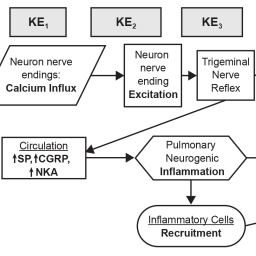Activation of TRPA1 by volatile organic chemicals leading to sensory irritation
Main Article Content
Abstract
Many volatile organic chemicals (VOCs) have not been tested for sensory pulmonary irritation. Development of an in vitro non-animal sensory irritation assay that is suitable for a large number of chemicals is needed to replace the mouse assay. An adverse outcome pathway (AOP) is designed to provide a clear description of the biochemical and cellular processes leading to toxicological effects or an adverse outcome. The AOP for chemical sensory pulmonary irritation was developed according to the Organization for Economic Co-operation and Development guidance including the Bradford Hill criteria for weight of evidence to determine the confidence in the AOP. The proposed AOP is based on an in-depth review of the relevant scientific literature to identify the molecular initiating event (MIE) for respiratory irritation. The activation of TRPA1 receptor (transient receptor potential cation channel, subfamily A, member 1) is the MIE leading to sensory irritation. A direct measure of TRPA1 activation in vitro should identify chemical sensory irritants and provide an estimate of potency. Fibroblasts expressing TRPA1 are used to determine TRPA1 activation and irritant potency. We report a linear relationship between the in vivo RD50 and the in vitro pEC50 values (R = 0.81) to support this hypothesis. We propose that this in vitro assay, after additional analysis and validation, could serve as a suitable candidate to replace the mouse sensory irritation assay.
Article Details
Articles are distributed under the terms of the Creative Commons Attribution 4.0 International license (http://creativecommons.org/licenses/by/4.0/), which permits unrestricted use, distribution and reproduction in any medium, provided the original work is appropriately cited (CC-BY). Copyright on any article in ALTEX is retained by the author(s).


